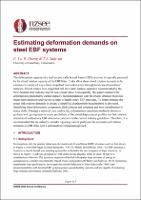| dc.description.abstract | The deformation capacity of a steel eccentrically braced frame (EBF) structure is typically governed by the chord rotation capacity of the EBF links. Codes allow these chord rotation demands to be estimated a variety of ways, from simplified hand calculations through to advanced non-linear analyses. Recent studies have suggested that the elastic analysis approach recommended by the New Zealand steel industry may be non-conservative. Consequently, this paper compares the deformations predicted by current industry recommendations with the results obtained from non-linear static pushover analyses for a series of multi-storey EBF structures. To better estimate the actual link rotation demands in design, a simplified displacement-based method is also used, identifying three deformation components (links, braces and columns) and their contributions to storey drifts. Through a series of case studies, the deformation-component method is shown to perform well, giving more accurate predictions of the actual displacement profiles and link rotation demands of multi-storey EBF structures compared to the current industry guidelines. Therefore, it is recommended that the industry consider replacing current guidelines for estimation of rotation demands on EBF links with a deformation component approach. | |

